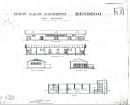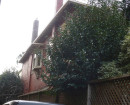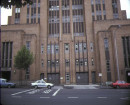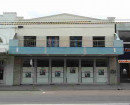Williamstown Botanic Gardens
Osborne Street WILLIAMSTOWN, Hobsons Bay City
Government Survey Heritage Precinct
-
Add to tour
You must log in to do that.
-
Share
-
Shortlist place
You must log in to do that.
- Download report


Statement of Significance
The Williamstown Botanic Gardens, originally laid out between 1856-60 by William Bull to a design by Edward La Trobe Bateman with later amendments by S Thake, at Osborne Street, Williamstown.
How is it Significant?The Williamstown Botanic Gardens are of local historic, aesthetic, scientific (horticultural) and social significance to the City of Hobsons Bay and the State of Victoria.
Why is it Significant?The significance of the Williamstown Botanic Gardens is described by Heritage Victoria as follows:
The Williamstown Botanic Gardens are historically important as one of Victoria's earliest and most intact botanic gardens and along with St Kilda, one of only two suburban botanic gardens established in the 19th century in Victoria. They are one of seven botanic gardens established in Victoria between 1846 and 1856. They are significant for the retention of the geometric layout typical of Victoria's earliest botanic gardens. The gardens have considerable significance for their strong association with eminent 19th century landscape designer Edward La Trobe Bateman and for their early connections with Ferdinand von Mueller and Daniel Bunce. (AHC criteria A4 and D2)
The Gardens are aesthetically significant for their excellent design and for the remarkably elegant execution of that design within a small, flat site. Important facets of the layout are the major north-south and east-west axes, the vista to Hobsons Bay, the impressive central palm avenue, the major focal point around the AT Clarke statue and the deliberately enclosed nature of the site which enhances the wide variety of internal views and spatial experiences within the framework of the formal layout. The striking palms (Washingtonia Robusta, Phoenix canariensis and Butia capitata) with their different forms and colour, provide a dramatic and contrasting landscape character against the evergreen and deciduous background. The strikingly intact Victorian layout, early tree plantings, the palms, the pinetum and the pond, structures and herbaceous and woody plantings from the Edwardian period all contribute to the picturesque landscape. (AHC criteria B2, E1 and F1)
The Gardens have scientific (horticultural) significance for their collection of plants, particularly the dominating palm and conifer themes and the large quantity of plants remaining from the Edwardian and Victorian periods. The Crinum asiaticum is rare in cultivation. The 19th century pinetum, densely planted with a collection of conifers displaying interesting forms and foliage, is significant as an enclosed dark, evergreen space forming an effective windbreak for the Gardens in their coastal setting. It features a central avenue and two outside rows of Cupressus macrocarpa, a row along the south boundary and a Pinus halepensis row along the east and west boundaries. (AHC criterion B2)
The Gardens are socially important for their long and continuous relationship with the citizens of Williamstown, who were largely responsible for their creation and early development and who continue to use them as a place of recreation. (AHC criterion G1)
Note: Included on the Victorian Heritage Register as VHR H1803.
-
-
Williamstown Botanic Gardens - Physical Description 1
Williamstown Botanic Gardens now occupy the 10 acres originally reserved in 1856 and comprise two distinct sections; the northern area containing what is known as the 'gardens proper', and the southern portion containing the 'pinetum', which is also known as the Parker Reserve.
The following detailed description of the Williamstown Botanic Gardens is provided by Heritage Victoria:
Williamstown Botanic Gardens display a very strong design organised around a major north-south axis and a minor east-west axis. The two axes from a central cross around the 1891 AT Clarke statue which is the centrepiece and the main focal point within the gardens. A perimeter path and curving internal secondary and tertiary paths, (typical design features of other Edward Latrobe Bateman designed landscapes) surround the central axes, creating a variety of internal views and spatial experiences in contrast to the major north south view. The overall design, despite the internal informality, remains highly formal because of the two axes and the mirror-like symmetry of the north gardens proper and the southern pinetum of the Parker Reserve.
The northern section to the Clarke statue (gardens proper), exhibit a very strong sense of enclosure, bounded on the northern and eastern sides by an evergreen hedged chain wire fence with overstorey palms and on the western and southern boundaries with mature Aleppo Pines (Pinus halepensis) and a circular ring of Moreton Bay Figs (Ficus macrophylla) around the Clarke statue. An avenue of mature elms (Ulmus spp.) runs along the central east-west axis. With the exception of the major north-south axial view to Hobsons Bay from the pinetum, all other views are internal.
Paths throughout the gardens are surfaced with gravel and edged with either concrete or timber plinthing to grassed areas and with basalt rocks to garden beds.
Plantings and planting themes within the gardens almost wholly date from the late Victorian and Edwardian periods with palms and pines dominating the overstorey. Many herbaceous plants, shrubs and trees still growing in the gardens date from the period 1900-20. Due to the unbroken tradition of Victorian and Edwardian horticultural techniques employed in the maintenance of the gardens until very recent times, the site is a highly authentic and almost completely intact example of a late Victorian and Edwardian municipal garden. Plants of interest including a very large specimen of Poison Bulb, Crinum asiaticum.
In the north east quarter of the gardens proper, the major point of entry into the site is gained through a reconstructed (1987) set of magnificent cast iron and lacework double gates on the Osborne and Giffard Streets corner. The two pedestrian gates which form part of this structure are still original. The current layout of this area still reflects the change of design, which followed the 1907 removal of the first gardener's residence and the subsequent re-organisation of this quarter of the gardens. From this point, a broad path curves to the central north-south axis. Rock-edged garden beds from the period of re-organisation of this part of the gardens line this path, displaying remnant ribbon planting and each featuring a row of mature Canary Island Palms (c.1940-45) which link visually and structurally to the same palm species along the Giffard Street boundary. Adjacent to the path on its southern side, a lawn with a central 1960s specimen tree (Ulmus procera 'Louis van Houtte') is enclosed by Edwardian shrubberies. Throughout these shrubberies are a number of ivy-clad stumps of Washington Palms from Edwardian times removed in the 1960s.The north-west quarter is dominated by the c.1904 Thake pond with its surrounding Guilfoyle influenced rockery, still planted with original succulents and palms. Security of the pond is provided by a 1987 timber post and iron rail fence with stanchions of the original Thake fence remaining. Immediately south of the pond is a 1906 dressed granite drinking fountain. A 1980s timber picket fence encloses the entire western boundary which is planted from Osborne Street to the Esplanade with mature Aleppo Pines (Pinus halepensis), possibly dating from the gardens' earliest days. Viewed from the Fearon Reserve, these pines provide a dominant spectacle in this part of Williamstown. Around the base of the pines are garden beds edged with volcanic rock. These date from the 1980s. The picket fence returns along the central partition between the gardens and the Parker Reserve pinetum. A flagpole of unknown date, the garden works area and the 1980s brick gardeners residence built on the site of the 1907 residence enclose the north west corner.
The central north-south axial path distinctly separates these two quarters. It is edged with a typical Victorian/Edwardian mown grass strip which in turn borders formal shrub beds with herbaceous plantings. An avenue of Mexican Fan Palms (Washingtonia robusta) planted in 1987 to replace the same species, dominate the axis to the Clarke statue. The statue is framed by a ring of mature Moreton Bay Figs (Ficus macrophylla) and Peppecorns (Schinus areira).
The south west quarter of the gardens proper is bounded by the Fearon Reserve on the western side and on the southern side by the pinetum. It contains largely open lawn areas with a row of mature elms along the east-west axial path.
Planting themes and layout in the south-east quarter are very similar to the south west with a greater area (in contrast to the original Bateman design), devoted to lawns and less shrubbery.
Many original trees in the gardens and pinetum are of unusually small stature, reflecting the impact of year round southerly gales and the exposed coastal conditions of the site.
The pinetum retains its north-south axial path with a direct view across the Esplanade to Hobsons Bay. Lacking a built edge, however, this path is less formally rigid than the same axis through the gardens proper. Virtually no visual evidence remains of the once intricate path layout of 1858-59, though subtle changes in the ground levels of this area indicate the location of earlier paths. The major pine species are Pinus halepensis, P. Canariensis and P. Radiata with many original trees still standing.
An open air bandstand (c.1930-45) constructed of volcanic rock is situated on the north west quarter of the pinetum.
This information drew largely on Richard Aitkens Williamstown Botanic Gardens. Conservation Analysis and Policies for the Western Region Commission 1986, an interview with Shelley Wood, Gardener at the Williamstown Botanic Gardens (1979-92) and an interview with Anne Neale, architectural and garden historian.
Williamstown Botanic Gardens - Integrity
Integrity and condition
Integrity - Moderate. Condition - Good.
Williamstown Botanic Gardens - Physical Description 2
Context
The Williamstown Botanic Gardens is an integral part of the Government Survey precinct, and is related to the (somewhat diminished) cultural landscapes of the Fearon Reserve and Esplanade foreshore reserve, as well as contributing to the historic nineteenth century character of the adjoining streets.
Williamstown Botanic Gardens - Historical Australian Themes
Making Suburbs, Developing Cultural Institutions and Ways of Life.
Williamstown Botanic Gardens - Physical Description 3
Associations
Edward La Trobe Bateman, S Thake, William Bull, Williamstown City Council
Heritage Study and Grading
Hobsons Bay - Hobsons Bay Heritage Study
Author: Hobsons Bay City Council
Year: 2006
Grading:
-
-
-
-
-
WILLIAMSTOWN PRIMARY SCHOOL
 Victorian Heritage Register H1639
Victorian Heritage Register H1639 -
RESIDENCE
 Victorian Heritage Register H0487
Victorian Heritage Register H0487 -
ST HELLIERS
 Victorian Heritage Register H0560
Victorian Heritage Register H0560
-
'Altona' Homestead (Formerly 'Laverton' Homestead) and Logan Reserve
 Hobsons Bay City
Hobsons Bay City
-
-












